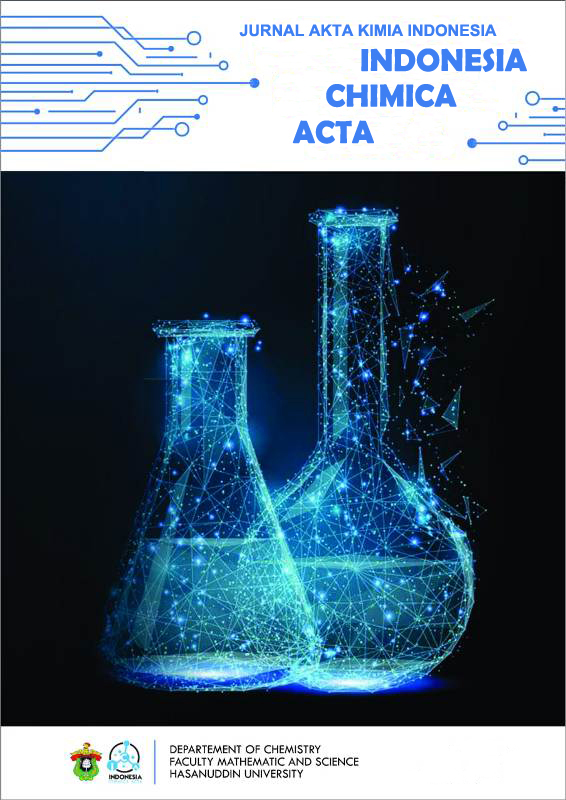Synthesis and Characterization Of Silver Nanoparticles Using Water Extract of Sarang Semut (Myrmecodia pendans) For Blood Glucose Sensors
Abstract
The principles of green chemistry in nanotechnology is one of the key issues in nanoscience research. Biosynthesis of nanoparticles using plant extract is an eco- friendly approach which eliminates the need for using physical and chemical techniques. A green synthetic route for the production of stable silver nanoparticles (AgNPs) by using aqueous silver nitrate as metal precursor and Myrmecodia pendans extract as bioreductor and PVA as stabilizer is being reported for the first time. In this case, the synthesis of silver nanoparticles (AgNPs) was carried out by reduction method. The bio-reduction and stabilization of so formed silver nanoparticles was monitored by UV-Vis spectrophotometry. Maximum absorption of AgNPs using Polyvinyl Alcohol (PVA) was at wavelength 408.50 nm, whereas that of AgNPs without using PVA was at wavelength of 408 nm. SEM images showed that the morphology of AgNPs was globular. An average size of silver nanoparticles using PVA and without using PVA was 78.3 and 76.1 nm, respectively. The results of X-Ray Diffraction (XRD) displayed the same peak pattern with that of the standard silver metal showing that the resultant particles are silver nanoparticles having FCC structure. Analysis of glucose levels in blood using silver nanoparticles based sensors showed glucose concentration of 71.71 mg / dL.
Full text article
References
Ahmed, S., Ikram, S. 2015. Silver Nanoparticles: One Pot Green Synthesis Using Terminalia arjuna Extract for Biological Application. J. Nanomed Nanotechnol 6(4): 1-6, ISSN: 2157-7439 JNMNT
Buzea, C., Pacheco, I. I. dan Robbie, K., 2007, Nanomaterials and nanoparticles: sources and toxicity, Biointerphases, 2(4):17-71.
Chandran, S.,P., Chaundary M., Pasricha R., Ahmad A., Sastry M.,. 2006. Synthesis of gold nanotriangles and silver nanoparticles using Aloe Vera plant extract. Biotechnology progress 22 : 577-583
Dangi, R., Shakya, S. 2013. Preparation, Optimization and Characterization of PLGA Nanoparticle. Int J of Pharm & Life Sci. 4(7): 2810-2818.
El-Nour, K. M. M. A., Eftaiha, A., Al-Warthan, A. dan Ammar, R. A. A., 2010, Synthesis and Application of Silver Nanoparticles, Arabian Journal of Chemistry, 3: 135–140.
Engida, M.A., Kasim, S.N., Tsigie, A.Y., Ismadji, S., Huynh, H.L., and Ju, H.Y. 2012. Extraction, identification and quantitative HPLC analysis of flavonoids from sarang semut (Myrmecodia pendan). Industrial Crops and Products 41 (2013) 392– 396. Elsevier
Gupta V, Karar PK. Optimization of Process Variables for the Preparation of Chitosan-Alginate Nanoparticle. Int J Pharm Pharm Sci. 2011; 3(2): 78-80.
International Diabetes Federation (IDF). (2015). IDF Diabetes Atlas Seventh Edition. International Diabetes Federation (IDF). Diperoleh tanggal 30 Januari 2018 dari https://www.oedg.at/pdf/1606_IDF_Atlas_2015_UK.pdf
Khan, Z., Singh, T., Ijaz, J., Yousif, A., Al-thabaiti, S. A. dan El-mossalamy, E. H., 2013, Colloids and Surfaces B : Biointerfaces Starch-directed green synthesis , characterization and morphology of silver nanoparticles, Colloids and Surfaces B: Biointerfaces, 102: 578–584
Mittal AK, Tripathy D, Choudhary A, Aili PK, Chatterjee A, Singh IP, Banerjee UC (2015) Bio-synthesis of silver nanoparticles using Potentilla fulgens Wall. ex Hook. and its therapeutic evaluation as anticancer and antimicrobial agent. Mater Sci Eng C Mater Biol Appl 53:120–127
Mukunthan, K.S., Balaji, S. 2012. Cashew apple juice (Anacardium occidentale L.) speeds up the synthesis of silver nanoparticles. Intl. J. Green Nanotechnology. 4(2): 71–79.
Philip, D. 2010. Green Synthesis of Gold and Silver Nanoparticles Using Hibiscus rosa sinensis. Phys. E. Vol., 42: 1417–1424.
Rai, M., Yadav, A., and Gade, A. 2008. CRC 675— current trends in phytosynthesis of metal nanoparticles.Critical Reviews in Biotechnology. 28(4): 277–284.
Saeb, A. T. M., Alshammari, A. S., Al-brahim, H. dan Al-rubeaan, K. A., 2014, Production of Silver Nanoparticles with Strong and Stable Antimicrobial Activity against Highly Pathogenic and Multidrug Resistant Bacteria, The Scientific Journal, 1-9.
Shankar, S. S., Rai, A., Ahmad, A. dan Sastry, M., 2004, Rapid Synthesis of Au, Ag, and Bimetallic Au Core-Ag Shell Nanoparticles Using Neem Azadirachta indica Leaf Broth, Journal of Colloid and Interface Science, 275(4): 496–502.
Singh, C., Baboota, R.K., Naik, P.K., and Singh, H. 2012. Biocompatible Synthesis of Silver and Gold Nanoparticles Using Leaf Extract of Dalbergia Sissoo. Research Article 3(4): 279-285.
Torresdey, J.L., Gomez, E., Peralta-Videa, J.R., Parsons, J.G., Troiani, H., Jose-Yacaman, M. 2003. Alfalfa sprouts : A natural source for the synthesis of silver nanoparticles. Langmuir: 1357-1361
Authors
This is an open access journal which means that all contents is freely available without charge to the user or his/her institution. Users are allowed to read, download, copy, distribute, print, search, or link to the full texts of the articles in this journal without asking prior permission from the publisher or the author.
Jurnal Akta Kimia Indonesia (Indonesia Chimica Acta) operates a CC BY-SA 4.0 © license for journal papers. Copyright remains with the author, but Jurnal Akta Kimia Indonesia (Indonesia Chimica Acta) is licensed to publish the paper, and the author agrees to make the article available with the CC BY-SA 4.0 license. Reproduction as another journal article in whole or in part would be plagiarism. Jurnal Akta Kimia Indonesia (Indonesia Chimica Acta) reserves all rights except those granted in this copyright notice.

